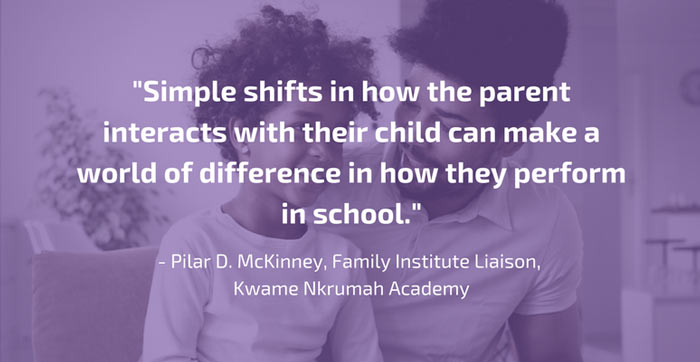In last month’s survey, we asked educators:
“What is the single greatest challenge you encounter in your role as an educator?”
Out of the responses we received, there was an overwhelming theme. The majority of survey respondents encountered the challenge of family engagement and buy-in.
Families who are engaged with what goes on in the classroom are more likely to communicate and interact regularly with their child about their education.

What Does Family Engagement Look Like?
Family involvement is not the same as family engagement. “One of the dictionary definitions of involve is ‘to enfold or envelope,’ whereas one of the meanings of engage is ‘to come together and interlock,’” explains author Larry Ferlazo in Schools, Families, Communities. “Thus, involvement implies doing to; in contrast, engagement implies doing with.”
Family engagement is important for student success. Research shows that teachers are the most important people inside schools in terms of student outcomes. However, research points to families having an even bigger impact on student outcomes than teachers.
How can you assess whether you’re enacting family engagement or involvement strategies? SchoolMint identifies the following factors as successful family engagement activities:
- Families and school staff work together
- Engagement is ongoing and consistent
- Support and improve the learning and growth of students
4 Strategies To Increase Family Engagement
Many educators try to increase family engagement and buy-in. At the same time, it can be difficult to establish an understanding of both families and school staff.
If you’re looking to broaden and deepen your engagement efforts, try these 4 strategies:
1. Establish Communication
It goes without saying, communication between teachers and families is critical. A teacher’s initial outreach and conversations set the tone for the academic year. Introductory conversations are the opportunity to establish trust and your shared goals.
Lay out what learning and growth opportunities are ahead of the student’s academic year. Likewise, establish what communication channels work best for you. Provide access to your chosen channels, like email, texting, phone calls, or in-person meetings.
Keep in mind that a successful family engagement strategy requires two-way communication. Make this a the time for parents and guardians to share their expectations, opinions, and perspective.

2. Leverage Student Handbook Information
Knowledge is power. An easy way to provide this power to parents and guardians is with handbook information. Important content to provide includes your school’s unique:
- Mission statement
- Cultural values
- Policies and rules
- Curriculum support
- Contact information
- Academic Calendar
Try allocating a section of student planners with handbook information and a separate section dedicated to pages for parents.
3. Use Social Networks
In this day and age, many parents are active on at least one social network. Principals, teachers, and schools use social media as a proactive measure to connect with families and students. Try sharing information on Facebook, Twitter, or Instagram.
Social media is an excellent way to deliver news and updates along with promoting school pride.
4. Remain Consistent
Once family engagement begins to build, don’t drop off. Continue to implement these strategies and encourage a two-way dialogue with families.
Looking for more ways to increase family engagement? Check out these resources recommended by the U.S. Department of Education.